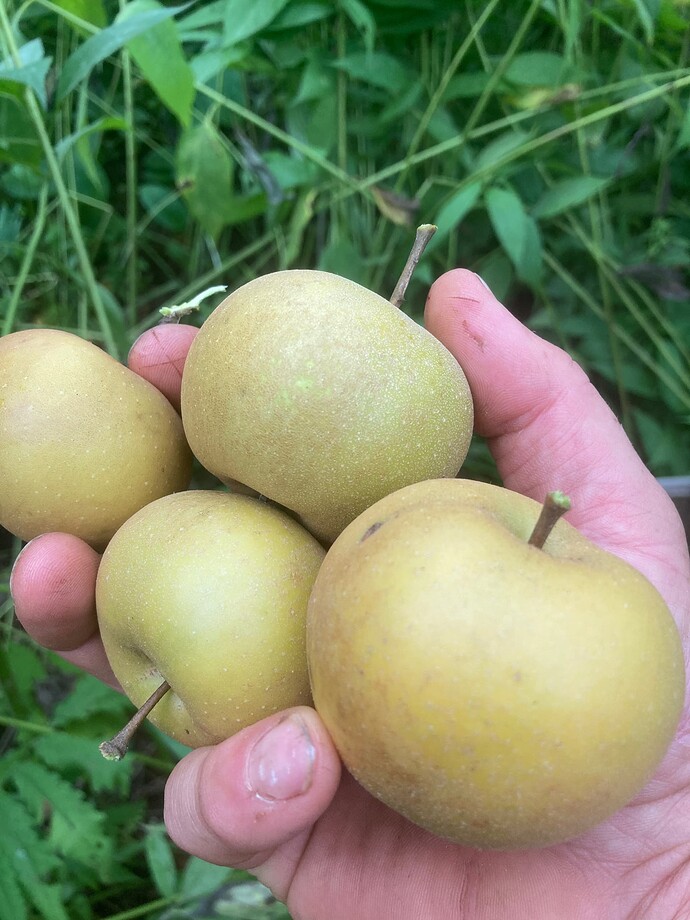Single site, single season evaluations are not reliable, and then we all have different tastes- yours may be very much drawn to sweet and non-acidic- but we can’t know how someone else is tasting fruit and what they even can taste. The biological mechanisms for our senses carry a range of possibilities within our species, but we tend to believe what we see, feel or taste is universal reality. There are people who can see ultra-violet colors, and they don’t even know it unless they are tested. The world they see is colored entirely differently than the one most of us do. And then there are the misnomered color blind, who see colors differently but aren’t anywhere near blind to it any more than those of us who can’t see ultra-violets- most with this condition only have trouble with red and green. They probably aren’t impressed by the appearance of Red Delicious- although the shape is pretty too.
I never know how a customer will react to an unusual apple. For instance, a couple weeks ago one tried a Yellow Transparent, which to me is barely worth eating when at its peak, as is the case for most people- the apples almost invariably go to waste on sites where I manage it- drop and rot or are food for wasps. This man liked the sour taste and foamy texture (it was at it’s best which is about two days before it becomes mush) and others on this forum have also defended this one.
I like high acid, high sugar, high density apples and consider Honeycrisp to be pretty boring and certainly not worth the headache of growing it without rot, but it is extremely popular with consumers. It’s value is far more controversial among the apple snobs who are a sizable portion of folks on this forum. I only grow it for the less apple jaded and experienced friends who visit, but some people who do have plenty of experience with various apples will pick it as one of their favorites or the favorite. I wonder if they taste the range of flavors that other apples have and HC does not. It is great texture and juiciness with good sugar-acid balance but almost no aromatics- a lousy cooking apple- to my palate.
All that said, I believe you would have liked the St. Edmond’s apples from the tree I sampled the other day- the ones not over-ripe. My helper likes sweet apples and gets to sample a wide range of types, of course, and agreed it was world class. The customers love it and I know I would have no trouble getting takers for the fruit. For those that love Russets and want an early one, it is certainly worth trying a graft. I wouldn’t want a whole tree of it, and agree that it’s pretty awful once its over ripe- it doesn’t just lose texture, it loses its acid-sugar balance and turns flat. It may not store well given how quickly it turns on the tree.
I base this evaluation on the literature as much as this one experience. I quote Fruit, Berry and Nut Inventory. “Most beautiful of all Russets. Very juicy, crisp…Rich pear-like flavor that reminds one of a Seckel pear. Listed as one of the six best apples to grow in England and regarded as the best early russet.” I don’t think the last phrase means only as grown in England.
Cummins Nursery has this description. “The flavor is exceptional when fully ripe. In Apples of Uncommon Character, Rowan Jacobsen writes: “Like vanilla pudding infused with pear essence. Early in the season, the richness can be masked by a blast of lemony acid, but this gives way to a yellow-cake flavor.” The texture is finely grained, crisp, and meltingly delicate. St Edmund’s Russet is not a storage apple; eat it quick!”
The apples I ate the other day had that lemony acid blast. They were much larger than the ones you are holding in the photo and those might have suffered from too little thinning or too little sun or a range of other possible issues related to conditions more than the cultivar.
![]()

